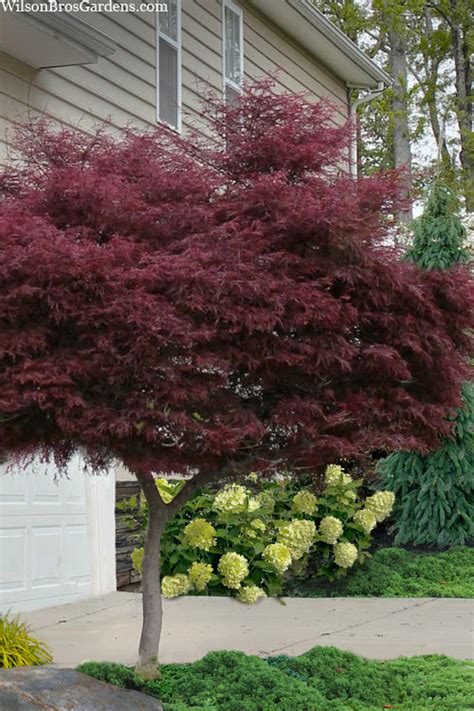How Much Is A Japanese Maple Tree Worth
Ronan Farrow
Mar 29, 2025 · 3 min read

Table of Contents
How Much is a Japanese Maple Tree Worth? A Comprehensive Guide
The value of a Japanese Maple tree isn't a simple number you can find on a price list. Its worth depends on a multitude of factors, making it more of a nuanced assessment than a straightforward calculation. This guide will break down the key elements that influence the price of these beautiful trees.
Factors Affecting the Price of a Japanese Maple Tree
Several key factors significantly impact the cost of a Japanese Maple:
1. Size and Age:
This is arguably the most significant factor. A small, young sapling will be considerably cheaper than a mature, established tree, potentially costing hundreds or even thousands of dollars more. Larger specimens, especially those with exceptional branching and shape, command the highest prices. Think of it like real estate – size and location (or in this case, the nursery or garden center) directly impact the value.
2. Cultivar and Variety:
Japanese Maples boast a vast array of cultivars, each with unique characteristics like leaf color, shape, and growth habit. Rare and highly sought-after cultivars, such as 'Bloodgood' or 'Crimson Queen', will generally be more expensive than common varieties. The uniqueness and desirability of the cultivar directly correlate with its cost.
3. Overall Health and Quality:
A healthy tree with vibrant foliage, strong branching, and no signs of disease or pest infestation will naturally fetch a higher price. A tree that's been well-maintained and displays excellent characteristics will always be more valuable. Look for a sturdy trunk and well-balanced canopy.
4. Source and Reputation:
Reputable nurseries and garden centers known for their quality plants often charge more, reflecting the care and expertise invested in growing and maintaining their stock. Buying from a trustworthy source often translates to a healthier and more valuable tree in the long run. While you might find cheaper options elsewhere, quality should always be a priority.
5. Container Size and Root System:
Larger container sizes generally indicate a more established root system, leading to better survival rates after planting. Trees with robust root systems are more likely to thrive and are therefore more valuable. The root system's health is crucial for long-term growth.
6. Location and Demand:
Supply and demand also play a role. In areas with high demand for Japanese Maples, the prices may be higher than in areas where they are more readily available. Local market factors influence pricing.
Estimating the Cost: A Range of Possibilities
While impossible to give a precise figure without specific details, you can expect a broad range:
- Small saplings (under 3 feet): Could cost anywhere from $20 to $100.
- Medium-sized trees (3-8 feet): Generally range from $100 to $500.
- Large, mature trees (over 8 feet): Prices can easily exceed $500 and reach several thousand dollars for exceptional specimens.
Beyond the Price Tag: The Value of a Japanese Maple
The true value of a Japanese Maple extends beyond its monetary worth. These elegant trees offer unparalleled beauty, adding significant aesthetic value to any landscape. Their longevity and the joy they bring over the years make them a worthwhile investment, even if the initial cost seems substantial. Consider the long-term value and aesthetic enhancement these trees provide.
By considering these factors, you can get a much better understanding of the cost of a Japanese Maple tree and choose one that best fits your budget and landscape needs. Remember, investing in a quality tree from a reputable source will be a rewarding experience for years to come.
Featured Posts
Also read the following articles
| Article Title | Date |
|---|---|
| How Much Is A Tiny Diamond Chip Worth | Mar 29, 2025 |
| How Much Is A Bottle Of Belvedere | Mar 29, 2025 |
| How Much Is A Bottle Of Cooking Oil | Mar 29, 2025 |
| How Much Is A 2001 Gold Quarter Worth | Mar 29, 2025 |
| How Much Does It Cost To Install A Snow Plow | Mar 29, 2025 |
Latest Posts
-
1 Cup Whole Walnuts Equals How Much Ground
Apr 03, 2025
-
0 27 Oz Perfume How Many Sprays
Apr 03, 2025
-
And Honey Treatment How To Use
Apr 03, 2025
-
500 In 1978 Is How Much Today
Apr 03, 2025
-
Zo Instant Pore Refiner How To Use
Apr 03, 2025
Thank you for visiting our website which covers about How Much Is A Japanese Maple Tree Worth . We hope the information provided has been useful to you. Feel free to contact us if you have any questions or need further assistance. See you next time and don't miss to bookmark.
